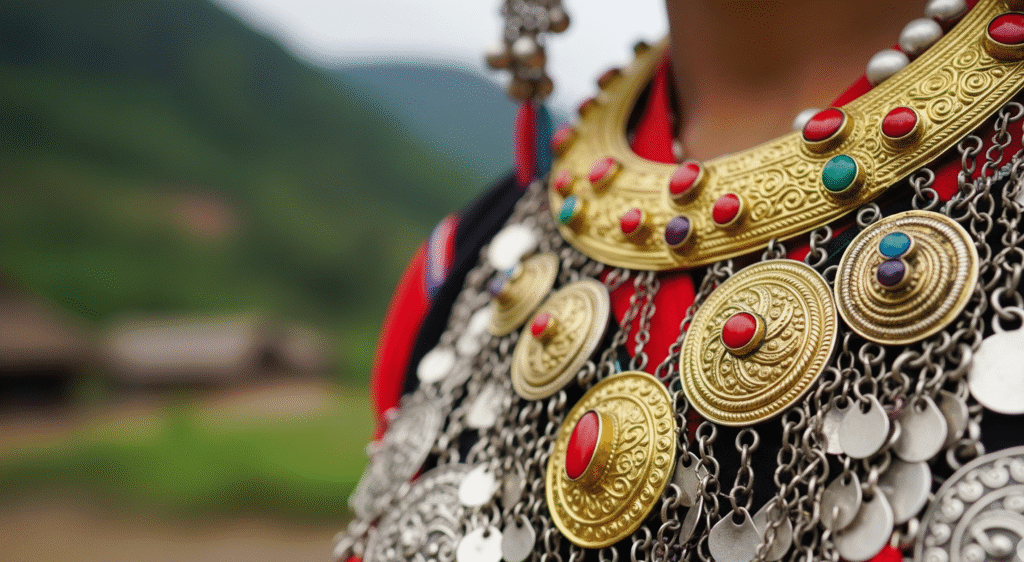Nagaland, here, art is not something confined to a gallery, it is worn, lived, and celebrated. At the very heart of this cultural expression is the stunning and deeply symbolic Nagaland jewellery.
This is not just about accessorizing. Each piece is a history book, a statement of identity, and a work of art. In this guide, we’ll look past the shimmer and explore the powerful stories behind the beads, brass, and bones that make Nagaland jewellery so globally unique and captivating.
More Than Adornment: It’s Nagaland Art

To understand Nagaland jewellery, you must first understand that it is a primary form of Nagaland art. For the various Naga tribes, these ornaments were a visual language. They told you everything you needed to know about a person: their tribe, their social standing, their marital status, and their achievements as a warrior or headhunter in eras past. Each color and material is a word; each complete piece is a story.
The Elements of Naga Design
The materials used are sourced from the mountains, forests, and rivers, and through ancient trade routes. The beauty of Nagaland jewellery lies in its raw, earthy, and powerful composition.
Key components often include:
- Beads: This is the cornerstone. Carnelian, agate, and various glass beads are highly valued.
- Brass and Bronze: Used to cast pendants, figures, and symbolic heads.
- Shells: Slices of conch shell were a sign of wealth and status.
- Bones and Tusks: Boar tusks and animal bones were symbols of strength and hunting prowess.
- Seeds and Fibers: Natural, locally sourced materials used for threading and decoration.
The Iconic Nagaland Necklace: A Story on Your Chest
When people think of Naga adornments, they often picture the magnificent Nagaland necklace. These are not simple, single-strand items. They are elaborate, multi-layered masterpieces. A traditional necklace can be incredibly heavy, built with dozens of strands of brightly colored Nagaland beads. Often, a large conch shell piece or an intricate brass pendant serves as the centerpiece. Owning and wearing such a piece was a tremendous display of a family’s wealth and social importance.
Decoding the Symbols: A Quick Guide
The motifs in the jewellery are deeply significant. Understanding them gives you a new appreciation for the artistry.
| Material / Symbol | What It Represents |
| Brass Heads | Traditionally symbolized success in headhunting; a mark of a great warrior. |
| Carnelian Beads | A sign of wealth and high status. |
| Boar Tusk | Represents the wearer’s physical strength and bravery. |
| Tiger Teeth/Claws | Reserved for warriors of great renown; symbolizes immense power. |
| Blue Beads | Blue was a rare and precious color, often indicating significant value. |
The Nagaland Medal of Honor
In Western culture, a soldier wears a medal to show valor. For the Naga tribes, a piece of jewelry served a similar purpose. The iconic brass heads worn on a necklace or as a pendant acted as a symbolic Nagaland medal. It was a clear, unambiguous sign of the wearer’s achievements and fierceness. This wasn’t just decoration; it was a wearable resume of a warrior’s life, earning him respect and authority within the tribe.
Buying a Piece of History: Nagaland Jewelry and Antiques
Today, you can acquire your own piece of this incredible culture. When shopping, it’s important to know what you’re looking for. There is a lot of contemporary nagaland jewelry made for the modern market, which is beautiful and helps support local artisans.
However, for collectors, the real treasures are the Nagaland antiques. These are pieces that have been worn and passed down through generations. An antique piece has a weight and patina that cannot be replicated. When searching for antiques, look for signs of wear, natural aging of the materials, and buy from reputable dealers who understand their history. Genuine Nagaland jewellery that has seen life is a powerful artifact to own.
Frequently Asked Questions (FAQs)
1. What is so unique about Nagaland jewellery?
Nagaland jewellery is unique because it’s a form of wearable art that tells a story. It’s not just for beauty; it signifies a person’s tribe, status, wealth, and achievements, making it a living piece of cultural identity.
2. What is the meaning behind the famous Nagaland necklace?
A Nagaland necklace is a symbol of status and wealth. Its size, the number of strands, and the rarity of its beads (like carnelian) and shells directly reflect the wearer’s importance in the community.
3. How does Nagaland art connect with the jewelry?
The jewelry is one of the most prominent forms of Nagaland art. The designs, patterns, and motifs are a traditional artistic language passed down through generations, making each piece an artifact of Naga creative expression.
4. Where can I find authentic Nagaland jewelry?
Authentic contemporary nagaland jewelry can be bought directly from artisans in Nagaland or from government emporiums. For true Nagaland antiques, you would need to visit reputable antique dealers in major Indian cities or specialized collectors who can verify the piece’s provenance.
5. What does the “Nagaland medal” signify?
The “Nagaland medal” isn’t a literal medal but refers to specific pendants, like the small brass heads, worn by warriors. These pieces signified a warrior’s success and bravery, functioning as a medal of honor within their tribe.
6. Are Nagaland beads valuable?
Yes, certain Nagaland beads are very valuable. Antique carnelian, agate, and old glass trade beads are highly sought after by collectors for their history, rarity, and the cultural importance placed on them by the Naga people.
7. Is all Nagaland jewellery very old?
No. While there are priceless Nagaland antiques, there is also a thriving community of artisans today creating contemporary Nagaland jewellery. These modern pieces use traditional techniques and designs, making this beautiful art form accessible to everyone.
